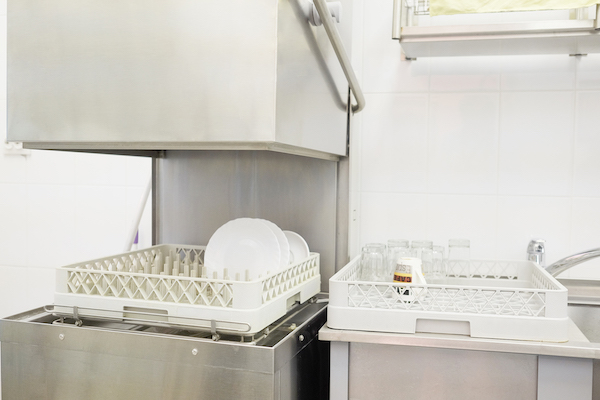




Catering companies, hotels, schools, restaurants etc. are some places which has operation of washing the contaminated dishes in the preparation and service phases. For each enterprise, the hygienic condition is very important. Washing dished can be done via manual washing or using machine dishwasher. In the 1980s, the number of enterprises with dishwashing machines was so few but dishwashing machines are used in all medium and large enterprises today.
The machines can be chosen according to the size of the enterprise and the number of meals estimated to be eaten per day. The optimization of operation costs of the washing machines is important for the financial controlling.
The cost of the dishwashing operation is often remembered with the “chemical” cost. However, there are other cost elements that contribute much more than the cost of the detergent within the grand total. These are electric power and water costs, personnel cost, machine repair/maintenance costs, breakage and erosion of the washed material and so on.
In order to ensure optimum dishwashing costs, the overall cost of the operation should be checked, taking into account all factors affecting the cost of the operation.
It is the cost of all kinds of personnel used to carry out all the related works within the flow of the dishwashing process. The grand total of all dishwashing operations we have asked the shop-floor employees. 45-50% of the total operating cost is personnel costs.
Collecting dirty dishes, stacking, transporting, pre-stripping, showering, pre-dipping, placing on the baskets, washing the machine, collecting the clean dishes, emptying the machine at the end of the work, cleaning and cleaning the interior and the parts etc. requires great dedication. In these stages, it is important to use the time efficiently and to make the work in the shortest possible time.
The results of the washing are to be efficient, the dirty stain rates minimized and the rewashing prevented are ensured with correct chemical choice, correct dosing, correct washing temperatures and correct program selection. The steps that should be taken before the washing are the important stages affecting the result. The correct separation and stacking of the contaminated dishes guarantees minimizing pre-washing, pre-dipping and re-washing.

It refers to the energy dishwashers use during heating, washing, rinsing and drying stages of the washing operation. For optimum use of the amount of electricity consumed by each machine, regular maintenance of the machine should be carried out, ensuring that the heaters are always clean and not covered with lime. Use of lime water or total dissolved salts with the high percentage of lime and mineral layer deposited, heating time and heating efficiency will drop, the water would try to raise the desired temperature for longer run. It is also important that the boiler in which the rinse water is heated, is not calcified. If the boiler is calcified with the use of hard water, descaling process should be carried out at the required intervals.
Ensuring optimum cleanliness of the dishes by providing optimum conditions in the above steps in the washing operation and preventing the washing cycles with the correct length washing programs will ensure optimum use of electricity.
In addition, full use of machine capacity and full running of the belts or tapes will ensure optimum operation of the machine.
The quality of the water used (hardness, total dissolved salts and silica values) is the most important issue in preventing stains remain on contaminated dishes after the washing. In the cases of high water hardness, re-washing, lime build ups etc. would increase due to unnecessary run. An important issue in the control of water use is the smooth operation of the overflow valve at the bottom of the machine and the avoidance of unnecessary water overflow. The hot water in the underfloor washing tank will not only cause unnecessary use of water, but also use extra electricity. As water will be thrown directly into the waste, it will cause more pollutants not only in terms of cost but also impacting the environment. The use of the dishwashing machine in full capacity and its full load as much as possible will also play an important role in the use of water.
New machines are continuously being developed by machinery companies for less use of washing and rinsing water.
Chemical cost:
It is important that the correct detergent is used in the correct dosage to make the contaminated dishes clean. The chemical dosage is adjusted according to the type of dirt and the hardness of the water. The optimum water absorption of 3-5 dH is ideal for optimum use of the detergent. Cleaning quality, water stains not remaining on the dishes, the heaters and the machine not calcifying, washing and rinsing jets preventing clogging of the water hardness are some of the reasons why correct dosage is checked. As the hardness increases, the dosage will need to be increased in appropriate amounts and thus the detergent costs will increase. Although the detergent will depend on the quality of the formula, usually the hardness will be greater than 1 g / l in every 5 dH increase.
In order to prevent re-washing and to ensure the full performance of the detergent, the coarse dirt of the collected dirty dishes and the pre-dipping with warm water, pre-dipping with a suitable non-foaming chemical will ensure the full efficiency of the chemical and minimize rewashing. Since washing and rinsing jets, clogged with dirt or food residues will reduce the mechanical effect of water, cleaning performance will decrease and rewashes will increase. For the optimum effect of the detergent, it is important to check and clean the jets at every machine shutdown.
One of the important cost points in the dishwashing operation is the breakage rate in the washed porcelain-glass objects. A good organization at every step of the operation will minimize the breakage.
With collecting the dirt, stacking and transporting to the washing area according to their types, the use of suitable transportation trolleys should be taken into account to prevent the excessive accumulation, to be careful of the personnel and to take necessary precautions will prevent breakage. Placing the glass objects as far as possible from one another, washing the glass with a lower alkaline product at a lower temperature prevent the glasses from fogging (corrosion) and scratching. The special cutlery of the cutlery handles will be washed down to ensure complete cleaning and rewashing will be prevented. Since the storage of cutlery and other metal items in a high alkaline product for a long time will cause corrosion and deterioration of the metal, the use of chlorinated and high alkaline products should be controlled and should be rinsed immediately after the procedure.
Particular attention should be paid to fractures and losses to prevent damage to the filters, heater and other parts of the machine, such as glass shards and cutlery that may fall into the washing tank.

Dishwashing costs have a significant impact on the profitability of the enterprise, controlling of the costs of the operation and optimizing the results; organizational arrangements, ensuring the compliance of the water quality, using the right products in the correct program and the regular maintenance of the machines will be possible by controlling all factors that affect the cost.
Eczacıbaşı Profesyonel Maratem provides professional kitchen hygiene products as well as cleaning and hygiene solutions to enterprises. With dilution units and dosing equipment as well as safe use of cleaning chemicals, cost control is ensured.